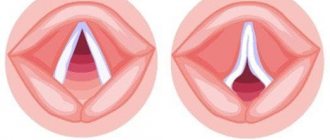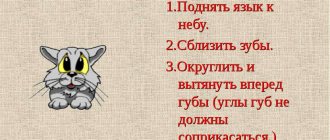What causes incorrect pronunciation?
The most common mistake adults make when communicating with their child is imitating his speech. We lisp with the little man, often distorting the words. It turns out that our speech drops to the level of a baby. Instead of speaking with young children as best we can, pronouncing all sounds and letters clearly, we deliberately make our speech unclear.
Since the child does not hear the correct speech from you, he will not be able to remember it and repeat it. Therefore, in order for your baby to learn to speak correctly, your speech must be clear and intelligible.
The reason for the incorrect reproduction of individual sounds may be a structural feature of the speech apparatus
- The ligament under the tongue is shorter than it should be, making it difficult to move.
- Normal speech is hampered by the size of the tongue (too small or, on the contrary, too large).
- Very thin or, conversely, plump lips, which makes their articulation difficult.
- Deviations in the structure of the teeth or jaw.
- A defect in the hearing aid that prevents you from hearing certain sounds and, therefore, from pronouncing them correctly.
Parents can easily correct some speech defects on their own. The baby experiences the main difficulties when pronouncing hissing sounds - Zh, Ch, Sh, Shch, the letters P, as well as Z, G, K, L, S and C.
Techniques for setting the sound
There are several methods for producing the sound Z:
- mechanical - performing exercises involving the use of speech therapy tools, for example, a spatula or spatula;
- Imitation is the simplest method. Preschoolers love to imitate adults; you can sit the baby in front of a mirror and show him the correct articulation of the sound Z. The child needs to carefully follow the movements of the organs of the speech apparatus and try to repeat what he saw;
- based on sounds that the child already knows how to pronounce correctly. For example, an adult shows a cup with his hands, and the child must repeat this position with his tongue, without sticking his teeth forward. When the baby succeeds, ask him to pronounce the sound Z, which automatically turns into Zh.
You can also place this sound on the basis of a correctly formed sound Ш. This is due to the fact that the articulation when pronouncing these sounds is the same. The baby says Sh, and the adult asks him to strengthen his voice and put his hand on his neck to feel the vibration in the vocal cords. To consolidate success, you need to ask your baby to imitate the buzzing of a bee or beetle.
How to help your child pronounce hissing sounds?
Teaching a child to pronounce the letters Zh, Ch, Sh, and Sh is a little easier than, for example, the letter R. Most often, children have a problem with the pronunciation of hissing Zh and Sh. At the same time, the sound Sh is not as annoying to the ear as the incorrectly pronounced Zh .
Usually the problem with hissing occurs because the baby is unable to relax the tongue and stretch it so that the edges touch the upper lateral teeth.
Therefore, the baby needs to be taught a few simple exercises.
- Let's relax the tongue . Place your tongue on your lower teeth, like a pancake, and tap it with your upper teeth, saying “Ta-ta-ta.” After this, the tongue should lie relaxed. Then you need to slap it with your upper lip and say “Pa-pa-pa.”
- Lifting the tip of the tongue upward . To complete the task, you need chewing candy or gum (it will be a good motivation for your child). You need him to open his mouth 2-3 cm, spread his tongue over his lower lip, sticking out its tip. Place a piece of candy on it and ask your child to stick it to the roof of his mouth behind his upper teeth. Make sure your baby only uses his tongue and not his jaw.
- Blow air through the middle of the tongue . Place a small piece of cotton wool on the table. Let the baby smile and position the tongue as in the previous task. The baby’s task is to blow the cotton wool to the other end of the table without puffing out his cheeks. At the same time, he must pronounce something like the letter F.
- Blow the cotton from your nose . The child opens his mouth slightly, places his tongue so that there is a groove in the middle of it, and the edges almost meet. We place a piece of cotton wool on the nose. The baby should take a deep breath of air through his nose and exhale sharply through his mouth. The cotton wool should fly up.
- We pronounce the sounds Zh and Sh . Ask the baby to pronounce the syllable SA, the tongue should be behind the teeth at this time. Then you need to move the tongue deeper into your mouth. As we move towards the alveoli, the sound from S turns into Sh. To get the sound Zh, we repeat the exercises, first pronouncing the syllable ZA.
- More words with Zh and Sh . Remember or come up with rhymes or tongue twisters where the letters Zh and Sh are often found in words. Repeat them with your child several times.
- We pronounce the letter H. If your baby has increased tongue tone, it will be more difficult for him to cope with the exercise at first. The sound CH consists of TH and Sh. First, the tongue should hit the alveoli, pronouncing TH, and then relax, passing the sound Sh through the slit. These two sounds, first slowly and then faster, should merge into one Ch. After several trainings, the baby will succeed !
Practice your pronunciation with different short rhymes. For example:
- There were jackdaws visiting the wolf cubs,
- There were wolf cubs visiting the jackdaw cubs,
- Now the wolf cubs are making noise like jackdaws,
- And like wolf cubs, the jackdaw cubs are silent.
Correct articulation of the sound Zh
The normal sound production of a hissing F is as follows:
- move the rounded lips a little forward;
- open your teeth a couple of millimeters;
- raise the relaxed tongue tip to the hard palate;
- let the air flow through the gap that forms between the lingual muscle and the palate;
- press the side edges of the tongue to the teeth, and lower its middle;
- pull back the back edge of the tongue.
Not all children have perfect command of the organs of the speech apparatus and cannot put their tongue in the correct position. Adults can explain many times how to do this, but a child cannot always understand it. Therefore, special articulatory gymnastics will be required, which with simple exercises will teach the baby to feel the components of his speech apparatus and correct pronunciation.
Learning to pronounce the letter R
The baby begins to pronounce the letter R well only at the age of 5-6 years. If your baby has not yet reached this age, do not panic ahead of time.
There are usually some problems associated with the letter P
- The little man does not pronounce the growling sound at all , it simply falls out of his word. This happens when the letter P is located between vowels. For example, a garage sounds like “ha - already”.
- The baby replaces the sound R with L, Y or Y. It turns out that instead of a rose - “vine”, red - “yzhy”, magpie - “jay”.
- The baby pronounces the sound R, but not the way it should sound in Russian . It either vibrates, like the British, or grates, which is typical for the French.
You can correct deficiencies in pronouncing the letter P by doing some exercises. It’s better to perform them while sitting and keeping your back straight. In this case, the child must see himself in the mirror.
This way he can see how well he completes the task.
- Sail . The child needs to open his mouth wide and lift the tip of his tongue behind his upper teeth. Bend the lower part of the tongue forward slightly and press the edges upward against the molars. You need to repeat this 3 times in a row for 10 seconds.
- Horse . You need to press your tongue tightly against the roof of your mouth and then quickly release it. This will produce a sound reminiscent of the clopping of hooves. Repeat the task at least 10-15 times.
- Turkey . Draw an angry turkey with the baby. The child should throw the tongue out of the mouth, pushing it between the teeth. In this case, you need to pronounce sounds similar to “bl-bl”. The task is performed at a slow pace, gradually speeding it up.
- Let's bite our tongue . Stick the end of your tongue out and open your mouth in a smile. Then slowly bite your tongue with your teeth.
- We brush our teeth . The baby needs to smile widely and move the tip of his tongue along the inner wall of the upper teeth, without moving the lower jaw.
- Who has it longer? Invite your baby to compare who has the longest tongue. Will he be able to reach his chin or the tip of his nose?
- Woodpecker . You need to open your mouth wide and tap your tongue hard on the inside of the gums near the upper teeth. At this time you need to say “d-d-d.”
To prevent your child from getting tired from numerous exercises, take breaks and invite him to roar like a lion. To consolidate the emerging successes, you can additionally learn tongue twisters and words that contain the letter R with your child.
Cause of burr
There are several reasons for the inability to correctly pronounce the sound “r”, the presence of which is worth paying attention to in order to subsequently eliminate the problem:
Low level of mobility of the speech apparatus. What does it mean? This condition can occur with low or, conversely, excessive tone of the facial muscles. Chances are you haven't seen your baby grimace much. And in this case, this lesson will just help you! Antics will serve as a kind of “gymnastics” for the face - curl your lips and tongue with a tube, stretch your smile wide “to your ears,” check how long your tongues are by trying to reach your nose and chin with them, move your jaws, and just have fun, friend in front of a friend or in front of a mirror.
- Short hyoid frenulum. Because of it, the tongue simply does not reach the roof of the mouth to be able to growl. This phenomenon is diagnosed by a speech therapist or surgeon. To eliminate the problem, they may prescribe special exercises for the tongue, which will help stretch it, or they may trim it a little.
- Phonemic hearing, namely its impairment. A child’s incorrect perception of adult speech leads to its distortion in his own performance. As an example, the word “love” is perceived by ear as “love”, “stick” as “beam” and vice versa, and so on. This can also be facilitated by the deliberate mispronunciation of adults when they “soften” hard sounds, as if copying the kid's funny and absurd pronunciation.
- Incorrect speech breathing. This type of breathing is disrupted by a runny nose, enlarged adenoids, immune diseases and diseases of the cardiovascular system. In this case, in addition to speech therapy exercises, individual physical exercises are prescribed.
- Throat "r". When trying to pronounce words correctly, the baby could get an easier version of pronunciation through trembling of the laryngeal uvula (in the French manner). In this case, retraining is necessary.
Having figured out the reason for the incorrect pronunciation and found out that it does not have serious origins that require mandatory medical intervention, you can try to help the baby yourself, following a certain course of action.
- Do not immediately set a difficult task for your baby. First, practice pronouncing the letter itself, having previously done the so-called articulatory gymnastics described below. When the first stage is consolidated, move on to the next one - pronounce the letter in syllables, then in words, and then you can learn tongue twisters to practice speech.
- Conduct regular classes with your child, otherwise the effect of the work done will be zero.
It is difficult to force young children to do something against their will, especially systematically. Turn your training into a game, and then you will achieve a positive result much faster, since the baby will learn with enthusiasm. Let him also make faces in front of the mirror. Be tolerant. In this painstaking work, success will not come to you immediately. It may take many weeks and months to achieve this.
It is important not to discourage your child from doing anything at all with your impatience and irritability. And even more so, God forbid you intimidate him!
Pronouncing the letters Z, S and C correctly
When a child does not pronounce the letter S, at the same time he cannot pronounce the other whistling letters and syllables - Z, Ts, Зь, Сь. The reason for this is an underdeveloped articulatory apparatus.
Special exercises will also help correct the situation.
- Drive the ball into the goal . The purpose of this task is to learn how to release a long, directed stream of air. Make gates on the table using blocks or other toys. Roll a loose cotton ball. The kid must, with his lips folded into a tube, blow on the ball and drive it into the gate. While performing the exercise, you should not puff out your cheeks, and the blown air should flow in one long stream, without interruption.
- Song of the tongue . With your mouth slightly open, you need to place your tongue on your lower lip. Then you need to spank with your sponges - “five-five-five” (the tongue sings). The air comes out in a smooth stream without interruption. Then, opening your mouth wide, hold the soft tongue on your lower lip so that it does not curl up. It is necessary that the edges of the tongue touch the corners of the mouth.
- Pancake . It is important to teach your baby to relax his tongue. To do this, he must smile and place the leading edge of his tongue on his lower lip. The smile should not be tense, and the tongue should only hang slightly from the lip.
- We brush our teeth . The exercise is similar to the task for the letter P, only we will brush the lower teeth rather than the upper ones.
The letter Z is paired with the letter C, so its production is done in the same way as the sound C.
The sound T consists of two sounds - T and S, which quickly move from one to another. It is important to teach your baby to separate one sound from another. Ask your baby to say first the long sound “shhhhh”, and then the short “shhhh, tshh, tshh” sound. As a result, the baby will make the sound C.
Exercises
All you need to start with is warming up the articulatory apparatus. To do this, do exercises for the tongue, lips and the entire speech apparatus.
Articulation gymnastics
“Pendulum”: the baby sticks out his tongue and moves it from the left corner of his mouth to the right.
“Brush”: open your mouth as wide as possible and use your tongue, like a brush, to paint the palate from the front upper teeth and as deep as possible to the throat. Such “coloring” games can be played out by using a new imaginary color every day.
“Mosquitoes”: the child opens his mouth and sticks the tip of his tongue behind his teeth, pronouncing a long sound z. Then the same is done, but the tongue must be moved to the palate, resting at the base of the upper teeth.
“Accordion”: the baby smiles and opens his mouth wide. You need to rest your tongue on the roof of your mouth as if you want to pronounce the sound “n”. With this position of the tongue, alternately open your mouth very wide, then close it. Do 15-20 times. This exercise helps stretch the short frenulum.
https://youtube.com/watch?v=TA7TNGwThsA
Lessons on automation and pronunciation of the sound “r”
In addition to articulation gymnastics, it is useful to perform speech therapy tasks. They are aimed at automating sounds, expanding vocabulary and forming the grammatical structure of speech. At the same time, memory is trained and logical thinking develops.
What about K and G?
The sounds K, G and X belong to the back of the tongue, which implies a high rise of the tongue when pronouncing them. When a child does not pronounce these letters, most often his tongue is simply lazy (with the exception of congenital pathologies that only doctors can correct). To make your tongue work, you need to do exercises.
Downhill skating . Place a cotton ball on your baby's palm. The baby should open his mouth slightly, hold the root of his tongue in a raised position, and lower the tip of it. Then you need to quickly exhale so as to blow the cotton wool from your palm. The sound will be K.
Spoon . Ask your baby to say “ta-ta-ta” slowly. Take a teaspoon and gently move your tongue away by pressing on the front of the back of it. Instead of “ta”, the baby will first get “cha”, and then “kya”. Continuing to press on the tongue, catch the moment when the baby produces a clean “ka.” He needs to remember what position his tongue was in at that moment. Don't worry if it doesn't work out right away.
Regardless of the exercises you do with your child to pronounce which letter, after class, repeat with him as many words, rhymes or songs with this letter as possible.
Do I need to contact a specialist?
You can conduct classes at home, but if over a long period of time parents fail to achieve a positive result, then you will have to seek help from a qualified specialist. Most often this is a speech therapist, neurologist or psychologist, depending on the reason for the inability to pronounce the letter “s”. Sometimes the help of a surgeon is required (if the reason lies in the incorrect anatomical structure of the articulatory organs).
Children begin to pronounce the whistling sound “s” at about 2 years of age. At 5 years old, a child should be able to pronounce it well. Moreover, both in hard and soft pronunciation. If by this age the baby does not say “c”, a visit to a speech therapist is mandatory.
If a person pronounces a whistling sound correctly, the position of the articulatory organs should be as follows:
- the corners of the mouth are slightly pulled back;
- teeth close together or slightly open;
- the very tip of the tongue should rest against the lower teeth;
- the back of the tongue from the front should approach the alveoli and form a small gap with them;
- Air should escape through the middle part of the tongue through the formed groove.











